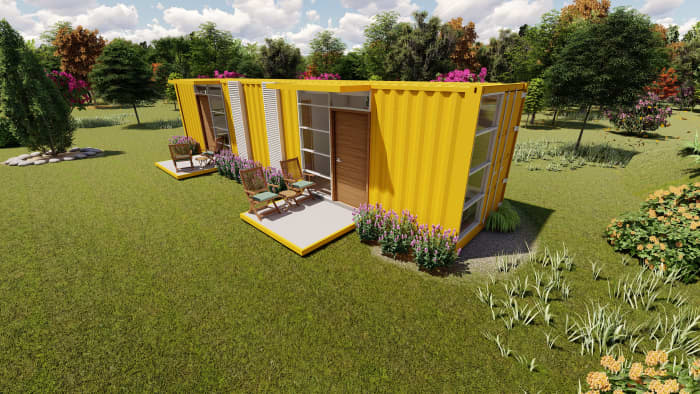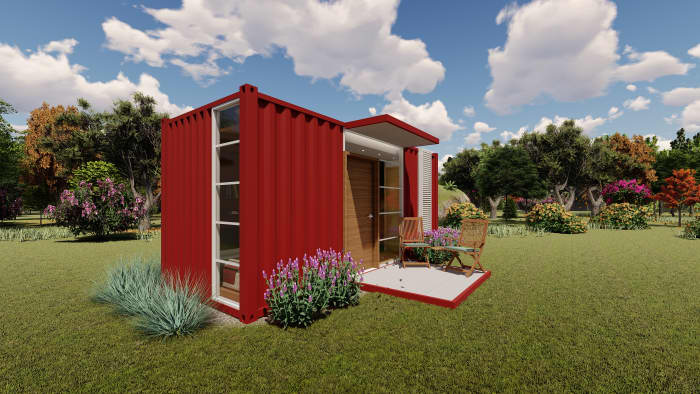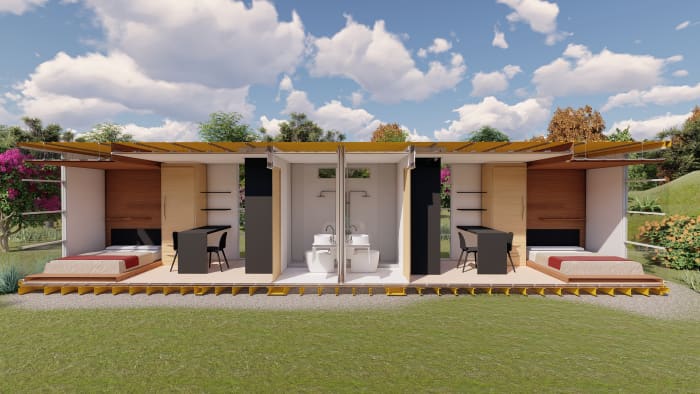Better Homes And Gardens Shipping Container 2021
Alexander is a professional engineer who specializes in the construction of affordable houses and structures using recycled materials.

A 40-foot shipping container home in florida
Are you considering putting up one or more shipping container homes in Florida? In this article, we cover the details and intricacies you need to be aware of as you consider this type of home. Let's start with the legal bit. Even before you start planning, you need to be sure that you're not violating the laws of the land.
In This Article
- Legal considerations
- The building process
- Costs
- Advantages
Is It Legal to Build a Shipping Container Home in Florida?
Yes, you can put up a container home in Florida, subject to various terms and conditions. You do, however, need to be aware of Florida's zoning laws. Before you acquire the land that you intend to put up your shipping container home, you'll want to be certain that no restrictions apply in that particular zone. Container homes are subject to the HUD code, which refers to the Manufactured Home Construction and Safety Standards for homes built in a factory.
It is important to note that the planning department in Florida divides the land and assigns regions for different uses including residential, commercial, and agricultural. Each of the above regions is further subdivided into zones R-1, R-2, R-3, and so on. In each of the zones, you can only build a specific kind of house. In this case, R-5, R-7, and R-15 zones do not allow container homes.
Once you confirm that your land is located in an appropriate zone, the next step is to acquire a building permit. Such a permit shows that your proposed project is in compliance with the relevant building codes and meets safety guidelines.
If the process seems too lengthy, you can involve a lawyer and a contractor to speed things along. Once you have the permit, you can proceed with the construction works.
Having a permit benefits you even beyond the building process. Think of home insurance. Most insurance providers will require to verify your permit before insuring your home. With your home built up to standard, you're assured of a favorable insurance package. Should you decide to sell your house in the future, the permit will assure the valuers or potential buyers that the building meets all requisite regulations and is safe for occupation.
You can familiarize yourself with some of the building codes in Florida here.

A 20-foot shipping container home
The Building Process
Is building a shipping container home in Florida any easier than building a conventional home? In many aspects, it is, since you already have the main structure in place. That said, building a container home is still a significant amount of work. Having obtained all the necessary permits, let's now look at the basic process of building container homes in Florida. You will need to hire professionals, such as an engineer, an architect, builders, and so on as the project demands.
The first step is to acquire structurally sound shipping containers. You'll decide the number and size of the containers depending on the magnitude of your proposed container home. Most container suppliers offer you the option of modifying the containers at their workshop.
Consult your container home builders to determine if it's more convenient to have the containers cut at the factory or if they'd rather do it at the construction site. Remember, a structural engineer must be consulted before any modifications are made, particularly those that involve cutting, as they affect the structural strength of the container and ultimately of the building.
Site Preparation and Foundation-Pouring
The site preparation process depends mainly on the condition of the building site, the house design, and the proposed budget. The foundation consists mainly of a concrete slab whose depth is determined by the geology of the site. Provisions are made for supply lines for gas, electricity, plumbing, drainage, sewage, and so on.
Container Modification
If you did not have the containers pre-modified, it is now time to modify them. There's a lot of cutting involved here to make space for windows, doors, and other passages. The cutting must be well-calculated to avoid compromising the structural strength of the building. After cutting out any panel, the opening should be reinforced with a steel frame. The bigger the opening, the stronger the reinforcement should be. Ensure that all of the joints are weatherproof.
Container Placement
The modified containers are now ready for placement. Here, a crane is used to place the containers on the foundation and stack them on top of each other per the building plans. This is one of the best aspects of container homes—their capacity to be stacked on each other at various angles. This is something that would be difficult to achieve with other building mechanisms. After fastening the joints at the points of contact, the structure is now in place.
Fixture Installation
The next step to install the doors, windows, ventilation, and partitions. With those in place, the fixtures come in; plumbing, electrical wiring, gas, and so on. Remember that the provisions for these were made during the foundation stage. With that, the building process is almost done. You can then involve interior and exterior designers to give your home the finishing of your choice.

Cutaway view of a shipping container home built using a 40-foot container
How Much Does It Cost to Build a Container Home?
Are container homes in Florida cheaper than brick-and-mortar houses? Unfortunately, since we do not have a standard cost for container houses, drawing a comparison here may not be as easy.
Read More From Toughnickel
Let's start with the cost of shipping the container itself. A 20-foot container typically costs between $1,500 and $3,000. A 40-foot container, on the other hand, can go for up to $4,500. You may also incur additional charges for transporting them to the site.
Simple container homes can go for between $10,000 and $35,000. A larger home utilizing multiple containers may require a budget of between $100,000 and $175,000. Do note that these figures are not fixed. They fluctuate depending on the details of your project.
Factors That Influence the final Cost
- Size and number of containers used
- Design and layout of the building
- Cost, if any, of cleaning the containers
- Electrical wiring
- Plumbing
- Flooring
- Bathroom and kitchen fixtures
- Doors and windows
- Insulation
You must have heard of simple DIY container homes going for as little as $5,000. Such stories give the impression that you can put up a container house within weeks and at a minimal cost.
If you're looking for a permanent home for your family, such a simple structure is hardly appropriate. A complete home requires many more amenities. Consult a contractor who can look at your design and give you an approximate cost breakdown. You can also shop around for ready-made container homes for sale.

Interior view of a shipping container home
5 Advantages of Shipping Container Homes
Are you still wondering if a shipping container home is right for you? Why should you opt for a container house as opposed to a conventional one? Here we explore some of the advantages that come with this mode of building.
1. Fast Turnaround
Building a traditional home takes months—sometimes even years. If you do not have the time or patience to wait for that long, a container home is a good alternative.
How long will it take to convert containers into a home? While there's no specific answer for this, it could take as few as eight weeks. Complex designs could take longer, but the duration will still be significantly shorter than other houses.
The container itself already offers the exterior structure of the house—walls, roof, and floor. You may decide to modify them, but that is still significantly less work than building them from scratch.
There's also the option of building a container home offsite. This further reduces the construction time since it eliminates travel to and from the building site. At the factory, all the tools, materials, and equipment required are already available, and the work progresses that much faster. Within weeks, you have a home ready to be transported to a site and fixed onto a foundation.
2. Portability
Can you imagine moving your entire house from one location to another? With container houses, this is not such a far-fetched idea. Shipping containers are designed with ease of transportation in mind. They can fit comfortably on the back of certain trucks and train cars and can even handle stacking during transportation. Even if your building spot is in a remote location, you can rest assured that your container home will be able get to you.
If you live in one area for some time then decide to move, you do not have to sell your house. With some professional help, you can detach the containers, transport them, then reattach them at the new site. Only a container home can give you such flexibility.
There are those of us who are comfortable enough to live in one area for all our lives or at least for the better part of them. Then there are those who are free spirits and want to go and explore. They want a home by the beach whose windows open to the sun and sand of the seaside. At another time, they want to live near a forest, so they can open their door to the greenery and feel one with nature. Only a container home can afford you this kind of lifestyle. You can simply put it on the back of a truck and transport it to wherever your next destination is.
3. Uniqueness
Using containers gives you the liberty to craft extraordinary house designs. You may have noticed that many houses in Florida have similar designs. Designing an exceptional house comes with a steep architectural cost, and most people end up going for the usual designs. With containers, you can create a truly bespoke home even without a hefty architectural budget.
Containers are designed to interlock for easy transportation. When building, this interlocking ability can be used to achieve various designs, configurations, and layouts. Containers can also be stacked for storied homes. With shipping containers, your creativity is the limit.
4. Strength and Weather Resistance
Shipping containers are made of steel, which is sturdy enough to withstand harsh conditions during transportation. At sea, they experience winds of up to 100 mph as well as turbulence from choppy waves. If you're looking for a home that can withstand extreme weather, then container homes should be on your list. They've already been tried and tested and passed the test. To extend the lifespan of your home, it is advisable to add external cladding to the container.
5. Environmental Impact
Most containers used for building have already outlived their shipping lifespan. In building houses, they serve a new purpose instead of being discarded. Given that thousands of shipping containers "expire" every year, disposing of them is a nightmare. When converted into houses, they can last for decades.
In many parts of the world, organizations have taken into using second-hand containers to build low-cost homes. In choosing a container home, you're also playing your part in reusing this product and ensuring it does not end up in a landfill.

Outside view of a shipping container home
Happy Building!
You are now well-versed in the details that you need to be aware of before settling on a container home. If you've decided that this is the best option for you, you can start the process of acquiring a container home in Florida. You can choose to buy the containers and build yours from scratch or just peruse ready-made container homes for sale. You can start by looking at the ready-made homes to see if you can come across one that suits your needs. If nothing jumos out at you, you can then hire contractors and build your own.
Is building any cheaper than buying? Well, in most cases, ready-made homes are more expensive. They will spare you the hassle of the construction process, but you'll have to pay for that convenience.
If you can't figure out which route you need to go, hire a contractor who specializes in container homes. You can then be guided in carrying out a comprehensive cost analysis so you can make an informed decision. Ultimately, with the exception of the three zones mentioned above, you can put up a container home in any other zone in Florida.
This article is accurate and true to the best of the author's knowledge. Content is for informational or entertainment purposes only and does not substitute for personal counsel or professional advice in business, financial, legal, or technical matters.
© 2021 Alexander Okelo
Better Homes And Gardens Shipping Container 2021
Source: https://toughnickel.com/real-estate/Are-Shipping-Container-Homes-Legal-In-Florida
Posted by: sumrallcalim1942.blogspot.com

0 Response to "Better Homes And Gardens Shipping Container 2021"
Post a Comment